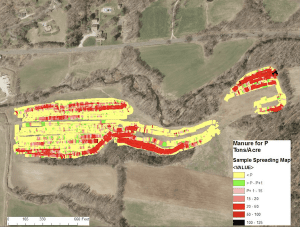
We have a multi-faceted approach to nitrogen management in Connecticut that addresses land use issues, agricultural production, and water quality.
Extension faculty from the Center for Land Use Education and Research (CLEAR) are working on several applied research projects in support of better nitrogen (N) management. They are collaborating with the University of Rhode Island and EPA to create an online tool, “N-Sink,” to track the movement of N in coastal watersheds (Highlights, 2020). In a project funded by the Long Island Sound Study (LISS), they are using cutting-edge high resolution land cover data to explore the relationship of land use to N export for the over 4,300 small watershed basins in Connecticut. Finally, the CLEAR geospatial team is part of another LISS study, led by Dr. Ashley Helton of the
Department of Natural Resources and the Environment, that is looking at “legacy” N loadings that are derived from past land uses that are no longer apparent but that continue to export N to our waters.
Rich Meinert is working with three farms on developing accurate as applied maps for farm applications. Current as applied maps provided by GPS systems are inaccurate on smaller New England farms. Our small irregularly shaped fields require spreaders to negotiate tight turns. Current generation software does not calculate the differences in as applied rates between the inside and the outside of a turn. Preliminary measurements using equipment on one of the farms has resulted in a 30% decrease in application rate on the outside of a turn versus the inside of the turn.
Another challenge in our smaller fields is overlap. Current spreaders have a fixed operating width. They throw lime, fertilizer, or manure with a set amount of force, across a fixed width, or they spray manure, or pesticides from a single point or a set of nozzles with a certain pressure and spray pattern, like a paint sprayer. Having a fixed application width and a varying field shape inevitably results in overlap. Certain sprayers can shut off nozzles to prevent overlap, but fertilizer and manure spreaders cannot vary their discharge. This research is currently collecting data to develop a computer algorithm to show where the nutrients are actually going so that future nutrient applications can target areas of fields that need it, and avoid areas that have had excess nutrients applied previously.
Visit CLEAR.uconn.edu and s.uconn.edu/nutrientmanagement for more information.
Article by Chet Arnold and Rich Meinert